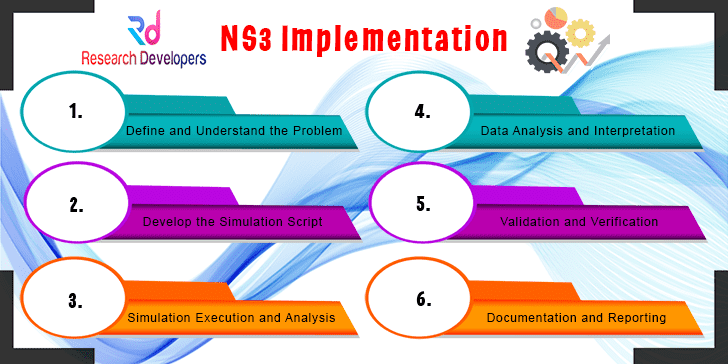NS3 Implementation
Where research begins: Expert guidance on topic selection.

NS3 Implementation
Network simulation is a computational procedure that involves the modelling of a computer network through the identification, analysis, and quantification of the interactions among different network devices and software. Mathematical modelling is employed as a means to examine the dynamics of a computer network, as opposed to relying on empirical data. Engaging in this activity has numerous benefits. Simulators are highly effective for evaluating network behaviour in harsh settings. Take, for instance, a node (a term used in network simulation to describe a computer system) that has the ability to move inside a wireless network. The behaviour of a node with high velocity can be readily examined through the utilisation of a simulator. Achieving high velocity for mobile nodes in a physical network poses significant challenges, and manipulating the velocity of mobile nodes for analytical purposes is a laborious and arduous endeavour.
Simulation emerges as the preferred approach in scenarios where the network exhibits a substantial number of nodes. For instance, while examining the functioning of a network of 1000 nodes, simulation emerges as the optimal approach, particularly until a definitive understanding of the outcomes is attained. Simulators are a viable option for doing network analysis in situations when financial resources are constrained, time is limited, or there is uncertainty over the efficacy of a given approach or protocol.
NS3 is a framework for creating basic programming models with the C++ language. It’s a discrete event packet simulator. Our research thesis program, NS3, is primarily intended for PhD students and research experts. We develop varied study projects for PhD students through Thesis. Our focus was on the creation and execution of unique network concepts that met the specific needs of users. We create theses and carry out networking projects using simulations like NS3, which are then simulated and tested. We used many theses including various unique protocols and methods to detect and avoid assaults using NS3 simulation. A large number of research-based applications have been developed using modern technology, including the use of simulation models.
-NS-3 is a collection of libraries that may be integrated and utilized with other software libraries. Certain simulation platforms provide users with a uniform graphical user interface environment in which all tasks are completed, whereas ns-3 takes a more modular approach in this regard. ns-3 can work with a variety of external animators and tools for data processing and visualization. Nonetheless, it is expected that users will do command line operations and use C++ and/or Python software development tools.
-NS-3 is primarily used on Linux systems, but it also supports FreeBSD and Cygwin (for Windows), and is being developed for native Windows Visual Studio.
A network simulator is a software application utilised to replicate the functionality of a real-world network on a single computer through the creation of scripts in C++ or Python. Typically, when doing experiments, we aim to observe the functioning of our network by manipulating different parameters. We lack the necessary quantity of computers and routers to create various topologies. Despite the availability of these resources, the construction of such a network for experimental purposes incurs significant costs. In order to address these limitations, we employed NS3, a discrete event network simulator designed for Internet applications.
NS3 facilitates the creation of diverse virtual nodes, which are analogous to physical computers. By utilising a range of Helper classes, NS3 enables the deployment of devices, internet stacks, applications, and other components onto these nodes. NS3 facilitates the establishment of Point-to-Point, Wireless, CSMA, and other types of connections between nodes. A Point-to-Point connection is equivalent to a Local Area Network (LAN) that connects two computers.
A wireless connection is analogous to a WiFi connection that facilitates communication between several computers and routers. CSMA connections are equivalent to bus topologies for interconnecting computers. Upon establishing connections, we proceed to deploy Network Interface Cards (NICs) on each node in order to provide network connectivity. Upon activating network cards in devices, many factors are incorporated into the channels, such as data-rate and packet size, which determine the actual path utilised for transmitting data. Currently, apps are employed to generate network traffic and transmit packets through these applications. Ns3 provides us with unique functionalities that can be applied to practical integrations.
Some characteristics are:
1. First, we may learn about the amount of data sent and received by following the paths that the nodes take thanks to NS3. In order to keep tabs on these actions, trace files are created.
2. The acronym “NetAnim” refers to a network animator.You may see the animation of the actual network design and the data transmission process from one node to another.
3.NS3 can help you create a pcap file that contains all the information about your packets, including their sequence number, source IP, destination IP, and more. The programme known as wireshark allows one to view these pcaps.
4. gnuPlot: We can create graphs using the data we acquire from the NS3 trace file using gnuPlot. When compared to other graphing tools, Gnuplot produces more accurate graphs while being easier to use.
Why NS3 simulation tool:
• Used to assess the effectiveness of current treatments
• Ad hoc Networks, Wireless Sensor Networks, and other wireless and wired networks are also simulated using it.
• Before usage, evaluates new network protocols
• Offers a simulation environment as well as support for different IP networks
• Used to conduct extensive experiments that are impossible to conduct in actual experiments.
When modelling and simulating communication networks, NS-3 is the tool of choice because of its discrete event-based network simulation capabilities. It also makes it possible to model the various OSI layers, from physical to application.
It uses a variety of models for transmission, mobility, topologies, protocols, etc., to facilitate effective modelling. In addition, the following are descriptions of the many modules and components that make it up:
• Core— the primary class responsible for model simulation and error correction;
• LTE NS3 (for LENA support) o Building o Spectrum o VoIP application
• Antenna
• WiFi (for EXTREME testbed-based WiFi model enhancement, debugging, and validation)
• Backpressure and Prism header/Radiotap trace support for routing protocols
• The Common Simulator is a packet class for scheduling
• The Node and Mobility class is a node for tracking the position of physical devices
• Devices, Internet Stack, and Routing—This section deals with protocols and components of networks.
Application programming interface abstraction is the role of the helper.
NS-3 Programme Structure
• Include “Header” files
• Include “Namespace”
• Activate or deactivate “Logging”
• Create the “Node”
• Establish the “Topology” for the newly created nodes.
• Configure the “Internet stack” and “Application”, settings.
• Execute the “Simulation” process.
The NS3 Features
• Access to Goodput
• DCE environment for simulation and emulation
• Support for script languages like Python and C++
• Dynamic maintenance
• One command for ultra-speed recompilation
• Power utilisation efficiency
• The ability to define MAC standards when needed
• NetAnim and PyViz (python visualizer) for network animation
• Capable of running NOC and MANET simulations
Other Services
- PHD & POST DOC Admission counselling
- Topic Section
- Review Paper Writing
- Systematic Literature Review (SLR)
- Research Paper Writing
- Synopsis Writing/Pre thesis writing
- Thesis Writing
- Data Analysis
- Questionnaire Preparation
- Developing Research Framework
- Methodology Development
- MATLAB Implementation
- Matlab Simulation
- Python Implementation
- Machine Learning Implementation
- Deep Learning Implementation
- VHDL Implementation
- Hadoop
- NS2 Implementation
- NS3 Implementation
- ArcGis Mapping & Analysis
- Spss Data Analysis
- Stata Data Analysis
- Amos Analysis
- R Programming
- E-Views Data Analysis
- Minitab Data Analysis
- Software Testing
- Ansys Implementation

